Marshall Speaker Reactance Emulator
|
This circuit was adapted from the patent document and the SE100 schematic with minor modifications. The Marshall schematic is based on bipolar power, so I adjusted it for unipolar power: added output cap, and low-noise Vref for mid-rail biasing.
The circuit is designed to make solid state amplifiers sound more like tube amplifiers by replicating the EQ caused by the interaction between the output transformer of a tube amp and the impedance of the speaker. It is especially useful for re-amping a tube amp through a solid state power amp, or adding to a DIY solid state amp. It is not a cabinet simulator, so if you want to record from a non-cabsimmed line output, or plug into a PA, you will probably want a separate cabinet simulator. Most modern, commercial solid state amplifiers already have a similar circuit built-in, so don't expect it to turn your Gorilla into a Bassman. It's also fairly useless in before distortion. I use it because I feed my Vox AC4TV into a resistive dummy load, tap it for line level, and send it to an LM386-based power amp (her name is Grace, in case you're wondering about the reference on the layout). Adding this circuit to the input of the power amp improves the tone noticeably, but it is not a drastic 'effect'. It's more of a sweetener. It's the permanent input stage to Grace. I originally intended to put a bypass switch on it, but when I tried it on the breadboard, I never wanted to turn it off, so I didn't bother. It's unity gain, plus a narrow boost around 125 Hz and a broad boost in the highs and upper mids. I find it fairly unhearable in front of distortion. It's most useful as a final fixed EQ stage before the power amp, which I avoid distorting. I played with it quite a bit on the breadboard and found no real benefit from adding any controls or changing any values, but you could add a volume pot on the input or output if you want to. I was happy with a 56k fixed resistor, though I ended up with a 68k resistor because I don't have any 56k SMD's and the difference is not noticeable. I had a fairly long discussion with someone about it on FSB, in case you want to read more. Two layouts here: one designed for how I use it (neither switchable nor adjustable), another for a stand-alone pedal with an intensity control and pulldown resistors, though I can't imagine anyone wanting to use this thing as a pedal. Verified by me. Pedal-version: 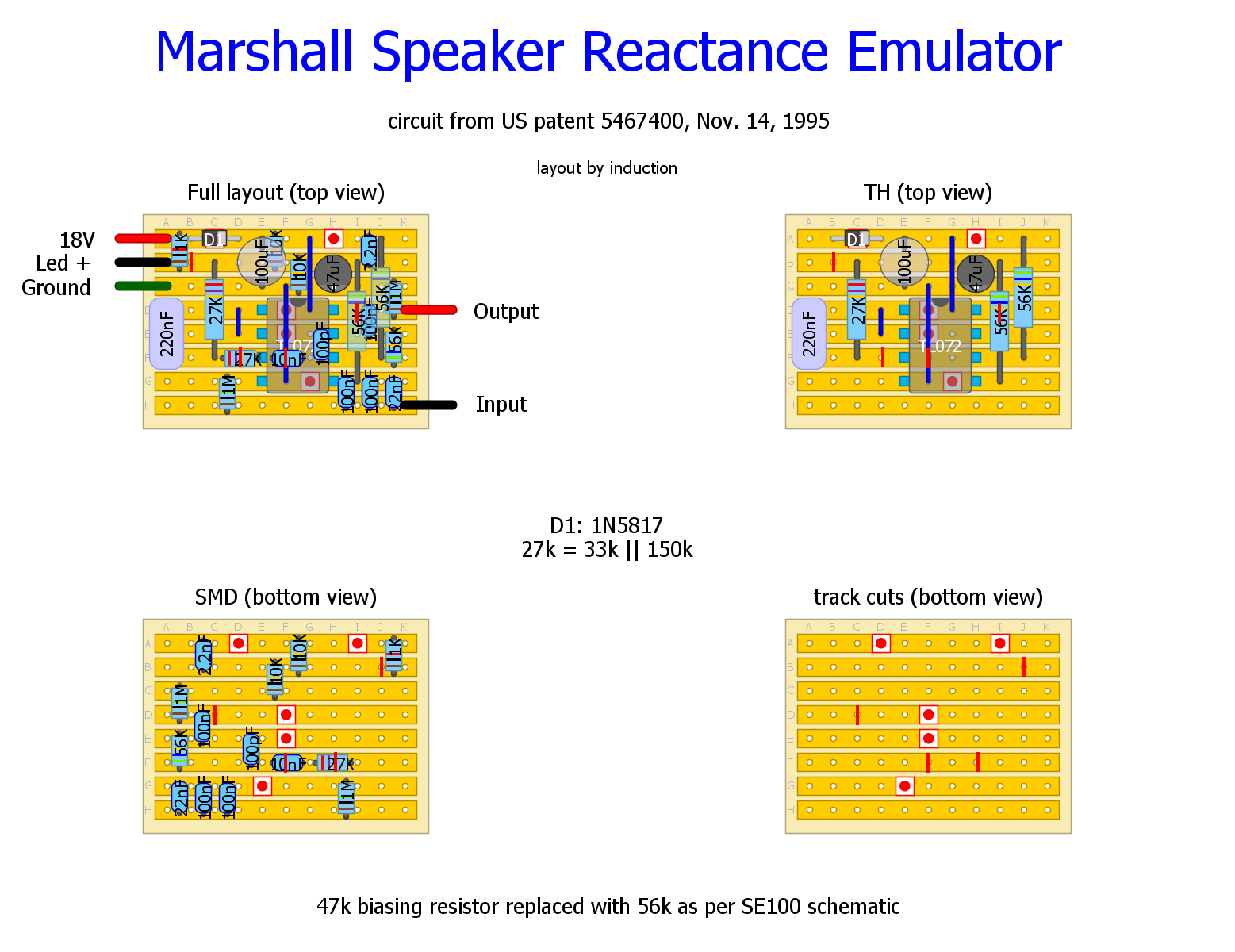 Version I built into my amplifier: 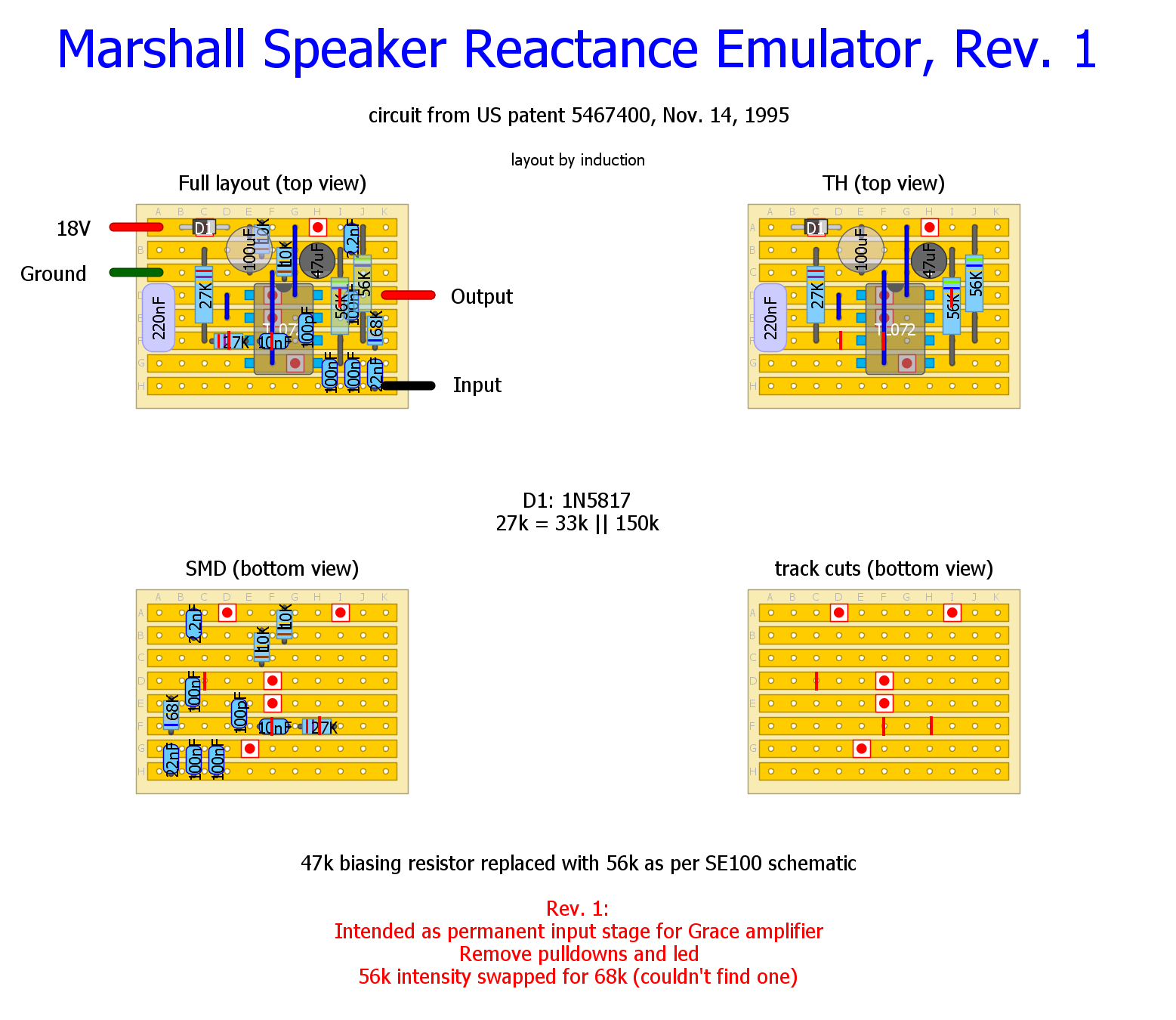 Schematic:  Frequency response (Input - green, Output - blue, amplitude - solid, phase - dotted): 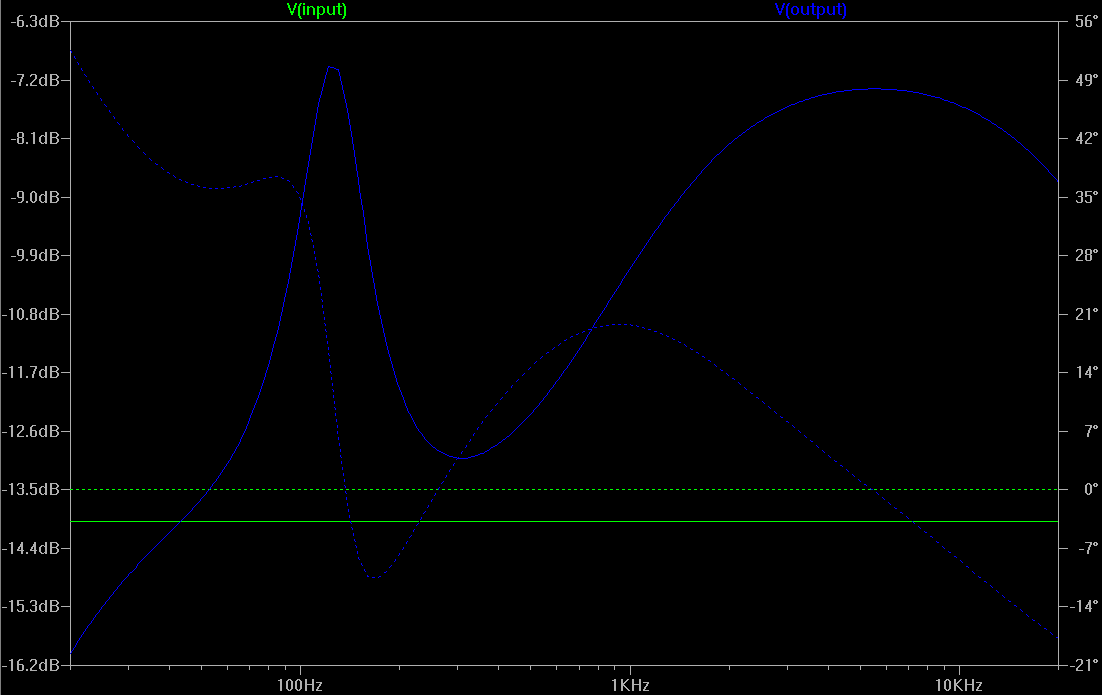
|
|
Very interesting, first I thought that this was designed to be used after a preamp and before a speaker simulation, Do you find it different from the stm sss? Have you tried them both at the same time? Do they help getting speaker cab simulations closer to the real thing? And your layout is amazingly little. Lots of thanks
|
According to the patent, it's purpose is to make a solid state amplifier sound more like a tube amplifier. To be more specific, the gain of a solid state power amplifier (no output transformer, lots of negative feedback) is largely independent of frequency, while the gain of a tube power amp (output transformer, especially one with little or no negative feedback) depends on the impedance of the load. The impedance of a guitar speaker looks like the frequency response curve I posted above, while the impedance of a resistor is frequency-independent. In other words, the frequency response of a tube power amp plugged into a resistor and tapped will be different from the same amplifier plugged into a guitar speaker. So if you tap the OT for a line level output, the sound will depend on whether the power amp is plugged into a speaker or a resistive load. The reactance emulator is just a frequency-dependent gain (aka EQ) that adds the gain characteristics of a tube amp plugged into a speaker back to the sound. It's useful for making solid state amps sound more like tube amps, and for making lineout signals from a tube amp sound more realistic in conjunction with a speaker simulator, but only if the amp is connected to a resistive dummy load instead of a speaker. Yes, they are completely different circuits. This one is an EQ, the SSS is an overdrive. The point of the SSS is to add clipping, not EQ. If you use both, put the SSS first. EQ after clipping sounds like EQ. EQ before clipping changes the distortion character. The reactance emulator is subtle enough that any clipping that comes after it makes it less effective. Usually. The basic question to ask is this: Are you playing through a tube amplifier directly connected to a speaker. If no, then use the reactance emulator. If yes, don't. In some cases, you make take a line level signal from a tube amp that's connected to a speaker cabinet, and use the cabinet as an on-stage monitor while sending the line level signal to a PA. In that case, you want a cabinet simulator, but not a reactance emulator (assuming your goal is realism). In another case, you may be reamping or directly recording a lineout from a tube amp with a reactive dummy load. In that case, again, you'll want a cab sim, but no reactance emulator because the reactive dummy load should interact with the OT to provide the signature power tube EQ. Yes, it's very small. I'm glad you like it. Here's a picture of my Grace amplifier. The amp circuit is the vero in the middle of the enclosure, the reactance emulator is the small one on the side next to the adapter jack. 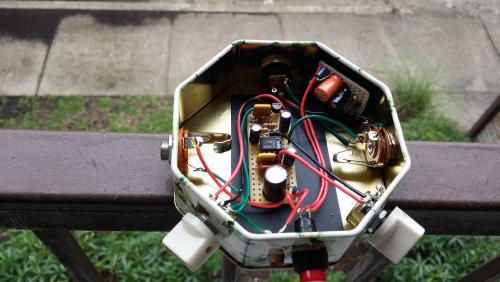 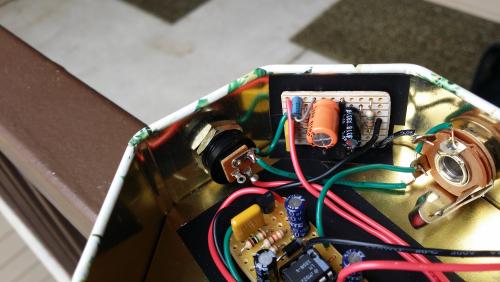
|
|
Lots of information! Thank you again, Induction!
 so the speaker saturation simulation its more or less like very soft od? In my research for more info about the circuit i found that it was referred to as some type of "tape saturation" instead of speaker , like the compression you get recording to reel. ThAnk you, as I said very useful. so the speaker saturation simulation its more or less like very soft od? In my research for more info about the circuit i found that it was referred to as some type of "tape saturation" instead of speaker , like the compression you get recording to reel. ThAnk you, as I said very useful.
|
|
In reply to this post by induction
thanks very much for the layout induction, and the very thorough explanation of its purpose and implementation which made me feel this is something i should try.
i don't have any smd anything atm but i think i may try using regular ones sort of wedged under first. that doesn't seem impossible. and more likely than my working up a full scale vero layout as my vero skills are generally shocking (not for lack of trying, just concentration issues due to health). sergio asked a couple of good questions i was thinking about, re when and why to implement. another one i have is what do you use for your dummy load? is that a build of your own design or adaptation? a decent dummy load build is still on my list, but i feel fairly incapable of sorting crap designs from good ones, re the diy options out there. and destroying my amp would be too high a price to pay for experimentation along these lines. can i also ask which diy cab sims you like most? have built (not tested) the rog condor which seems to be widely appreciated. alex has also done a multi cab sim in the layouts here which i might try. seemed to get approval at diysb, which is often a sign that it is what it claims to be. http://tagboardeffects.blogspot.co.uk/2016/01/multicab-simulator.html |
|
In reply to this post by Sergio
Yes the SSS is just a soft OD. To me it sounds a little like a Timmy with no EQ options. It's nice as a stand-alone od, but I'm one who agrees that most overdrives sound very similar. I'll answer in more detail when I post the SSS, which I'll do next. My dummy load is very similar to the Weber Load Line with a slightly more sophisticated tone control. (SWTC V3, though after implementing my reactance emulator, I keep the tone control on the lineout flat anyway.) I'll post the schematic and layout here if you like. Except for the tone control, no vero is necessary, it's just a power resistor in parallel with volume pot and series resistor. The trick is that you have to build the dummy load circuit specifically to suit the amp you want to use it with. The power resistor has to be able to handle twice the output wattage of the amplifier, and the lineout voltage divider has to give the appropriate range of output voltages. My amp is a tiny (1-4 Watt Class A), so it was very simple. If you want a dummy load for a 100 Marshall, you'll probably spend one or two hundred clams on power resistors alone. The Multicab is the only one I've built. I liked it on the breadboard, but I haven't tested my vero build yet, and I don't foresee much opportunity to use it. I built it as a backup, for the cases where I can't bring an amp and I have to plug into a stereo or a set of computer speakers or something. That used to happen a often enough, but I can't remember the last time I jammed with anyone, so building it was kind of like closing the barn door after the horse already escaped. For recording, I generally use impulses, not analog stuff. The Multicab would probably be useful for making a headphone amp, but I never play with headphones either. |
|
This post was updated on .
My DIY dummy load with 12" speaker impedance curve "emulation". It has 2x150w 8ohms power resistors in series for better heat disipation, so pretty much any 16ohms tap guitar tube amp should work here. I use it as a resistive/inductive/capacitive atenuator for my 100w amp, (sometimes just as a paralell dummy load along with my cab). Planning on adding a line out to record with my audio card.  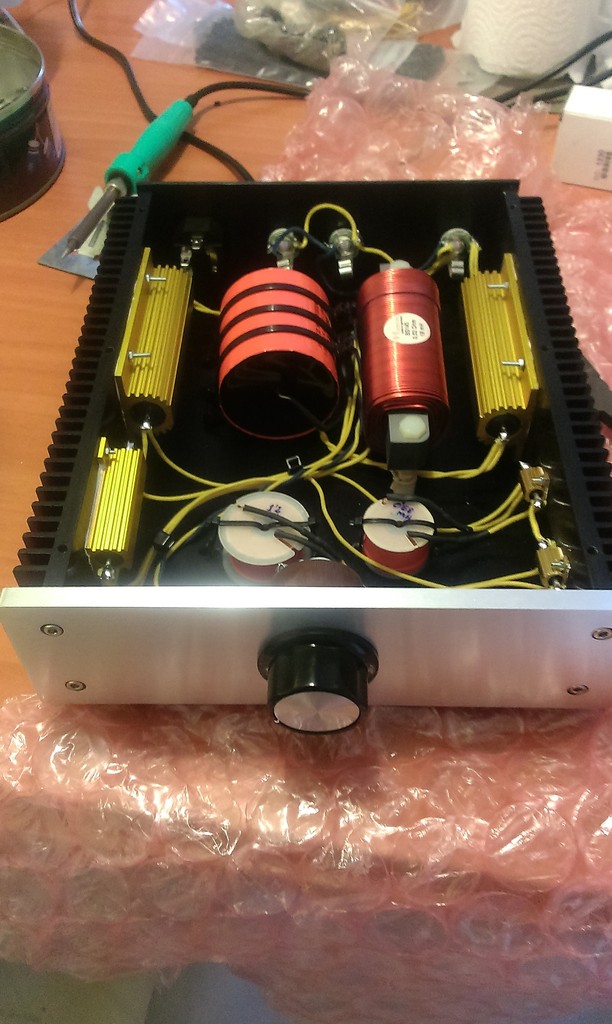 |
«
Return to Hybrid Layouts (Through-Hole/SMD)
|
1 view|%1 views
| Free forum by Nabble | Edit this page |

